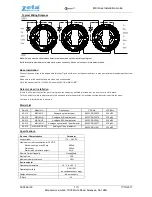
95-8546
2
17.3
The Auxiliary relay has normally open / normally
closed contacts, and is configurable for energized or
de-energized operation, and latching or non-latching
operation.
0 to 20 mA Output
A 0 to 20 mA output is available as an option (in addition
to the three relays). This option provides a 0–20 mA dc
current output for transmitting detector status information
to other devices. The circuit can be wired in either an
isolated or non-isolated configuration and can drive
a maximum loop resistance of 500 ohms from 18 to
19.9 Vdc and 600 ohms from 20 to 30 Vdc. Table 1
indicates the detector status conditions represented by
the various current levels. The output is calibrated at the
factory, with no need for field calibration. A model with
relays and 0–20 mA with HART is also available. Refer to
Addendum number 95-8636 for complete details.
NOTE
The output of the 0–20 mA current loop is not
monitored by the fault detection circuitry of the
detector. Therefore, an open circuit on the loop will
not cause the fault relay to change state or the
detector status LED to indicate a fault. The status of
the LED always follows the status of the relays.
An alarm condition will normally over-ride a fault condition,
unless the nature of the fault condition impairs the ability
of the detector to generate or maintain an alarm output,
i.e., loss of operating power.
LON/SLC Output
The EQP model is designed for use exclusively with
the Det-Tronics Eagle Quantum Premier system. The
detector communicates with the system controller over
a digital communication network or LON/SLC (Local
Operating Network / Signaling Line Circuit). The LON/
SLC is a fault tolerant, two wire digital communication
network arranged in a loop configuration. Analog and
relay outputs are not available on this model.
LED
A tri-color LED on the detector faceplate indicates
normal condition and notifies personnel of fire alarm
or fault conditions. Table 2 indicates the condition of the
LED for each status.
ATTENTION
The X5200 and X5200M contain a source tube
that is filled with a gas mixture containing Krypton
85 (Kr
85
), a radioactive material. Radioactive
materials are subject to regulation under U.S.
and international law.
Not applicable to model
X5200G, which does not contain Kr
85
.
oi
(OPTICAL INTEGRITY)
Automatic
oi
The X5200, X5200G, and X5200M include the Automatic
oi
feature — a calibrated performance test that is
automatically performed once per minute to verify
complete detector operation capabilities. No testing
with an external test lamp is required. The detector
automatically performs the same test that a maintenance
person with a test lamp would perform — once every
minute, 60 times per hour. However, a successful
Automatic
oi
test does not produce an alarm condition.
Table 1—Detector Status Conditions Indicated by Current Level
Current Level (±0.3 mA)
Detector Status
0 mA
Power Fault
1 mA
General Fault
2 mA
oi
Fault
4 mA
Normal Operation
8 mA
IR Pre-Alarm only
12 mA
UV Alarm only
14 mA
IR Alarm only
16 mA
Pre-Alarm
20 mA
Fire Alarm
Table 2—Detector Status Indicator
Detector Status
LED Indicator
Power On/Normal Auto
oi
(no fault or fire alarm)
Green
Power On/Normal Man
oi
Green, flashing off for 0.5 sec.
every 5 sec.
Fault
Yellow
UV Alarm only
Red, flashing on for
0.5 sec. and off for 0.5 sec.
IR Alarm only
Red, flashing on for
0.25 sec. and off for 0.25 sec.
Pre-Alarm
Red, flashing on for
1 sec. and off for 1 sec.
Fire (Alarm)
Steady Red
On Power-Up, The LED Flashes in Sequence as Follows,
Indicating Sensitivity and Signal Processing Status
Low UV Sensitivity
Medium UV Sensitivity
High UV Sensitivity
Very High UV Sensitivity
One Red Flash
Two Red Flashes
Three Red Flashes
Four Red Flashes
Stand. UV Signal Process.
Arc Rej. UV Signal Process.
One Yellow Flash
Two Yellow Flashes
Low IR Sensitivity
Medium IR Sensitivity
High IR Sensitivity
Very High IR Sensitivity
One Green Flash
Two Green Flashes
Three Green Flashes
Four Green Flashes
Quick Fire/TDSA IR Signal
TDSA only IR Signal
One Yellow Flash
Two Yellow Flashes























